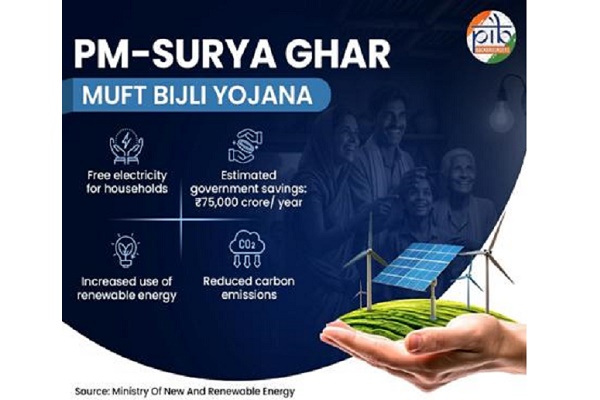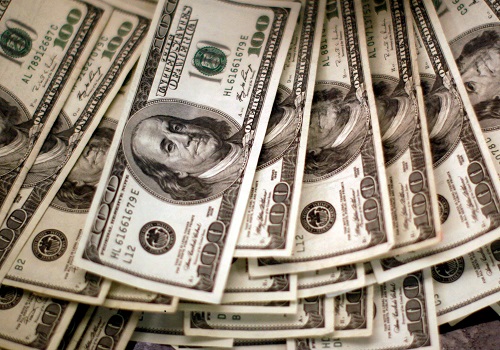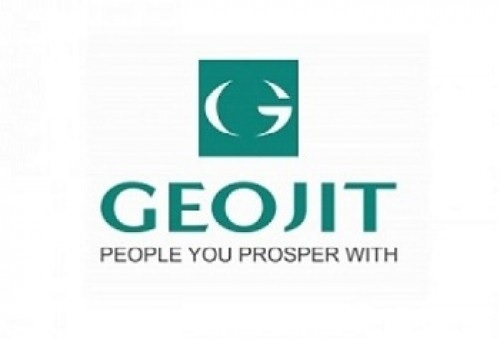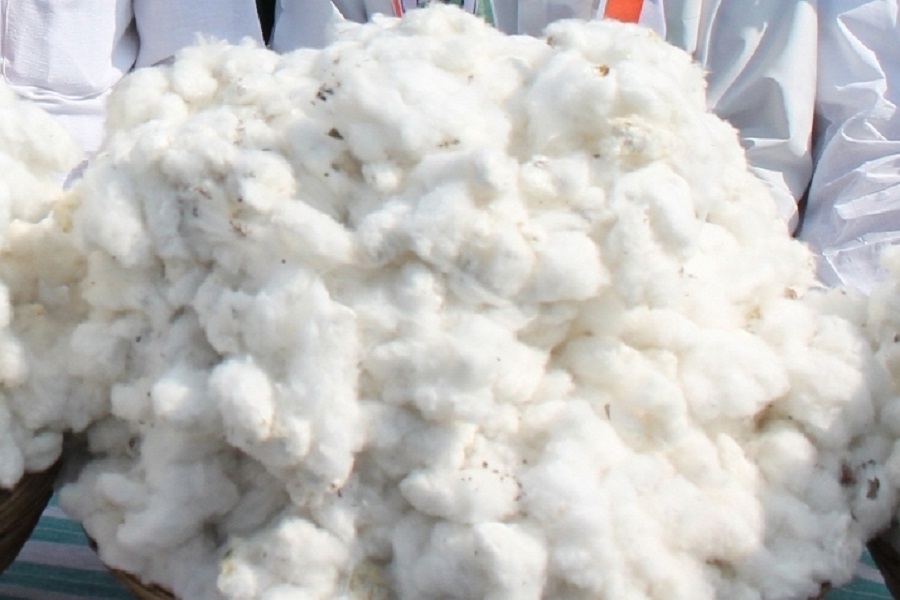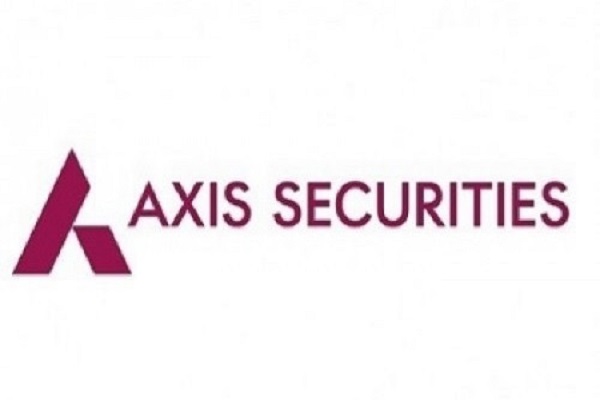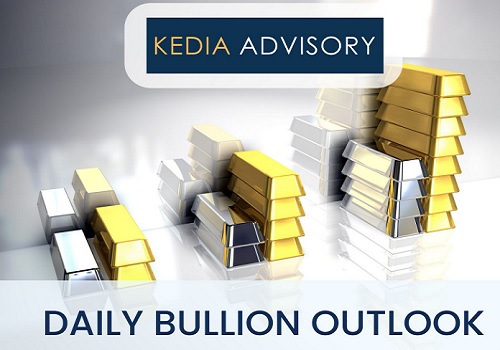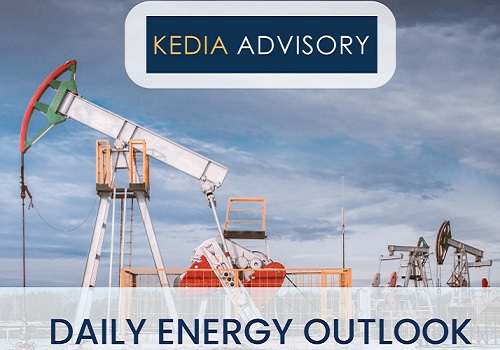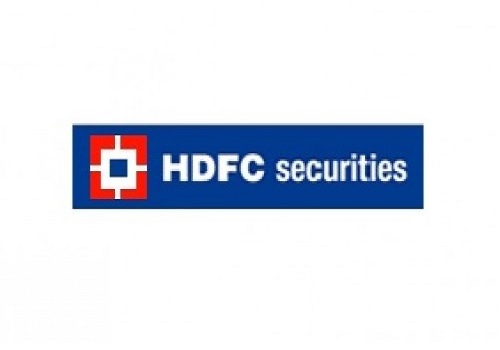Zinc trading range for the day is 286.7-300.7 - Kedia Advisory

Gold
Gold prices rose by 0.72% to settle at 1,21,364, supported by global economic uncertainty and heightened expectations of further U.S. interest rate cuts. With the U.S. government shutdown extending into its third week and political instability in France following the resignation of PM Lecornu, safe-haven demand for gold strengthened. Comments from Fed officials suggested a cautious approach toward additional rate cuts, reinforcing market expectations of a 25 bps reduction at the upcoming October 29 FOMC meeting, with a 94% probability. Goldman Sachs raised its 2026 gold price forecast from $4,300 to $4,900, citing sustained inflows into gold ETFs and strong central bank purchases. Physical demand in India remained resilient despite record prices, with dealers offering premiums up to $15 per ounce ahead of key festive demand. In contrast, China’s post-holiday buying was subdued, with discounts ranging between $48–$60 per ounce, while Hong Kong and Singapore saw mixed premiums and discounts amid profit-booking. Swiss customs data showed gold exports to China surged 254% in August to 35 tonnes, the highest since May 2024, while shipments to India also rose, underscoring strong Asian demand. Technically, the market is under fresh buying as open interest increased slightly by 0.04% to 16,589, while prices gained 871. Support is seen at 1,20,165, and a break below could test 1,18,965, whereas resistance is likely at 1,22,425, with potential upside toward 1,23,485 if momentum continues.
Trading Ideas:
* Gold trading range for the day is 118965-123485.
* Gold gains driven by global economic uncertainty, and growing expectations of further US interest rate cuts.
* Fed's Barr said that he does not think that there is a generalized spillover of tariffs onto services inflation.
* Goldman Sachs revised its 2026 forecast for Gold prices from $4,300 to $4,900, citing strong flows into Gold ETFs and central bank demand.
Silver
Silver prices edged higher by 0.10% to settle at 1,46,466, supported by strong safe-haven demand and ongoing supply constraints. The metal has surged over 70% this year—outpacing gold—amid growing U.S. fiscal concerns, expectations of rate cuts, and geopolitical uncertainties across the U.S., France, and Japan. Investor demand remains robust, driven by fears over global debt and central bank independence, while a shortage of freely available silver in the London market has further tightened supply conditions. The dual nature of silver demand—spanning both investment and industrial uses such as solar panels and renewable energy—has kept consumption on track to exceed supply for the fifth consecutive year in 2025. Silver-backed ETPs recorded net inflows of 95 million ounces in H1 2025, pushing global holdings to 1.13 billion ounces, just 7% below the 2021 peak. The total value of ETP holdings also hit a record above $40 billion. Retail investment in India rose 7% year-on-year, reflecting firm price expectations, while European demand continued recovering from lower 2024 levels. According to the Silver Institute, the global silver deficit is expected to narrow by 21% to 117.6 million ounces this year as supply increases modestly and demand eases slightly. Technically, the market is under fresh buying as open interest rose by 3.46% to 27,850 while prices gained 142. Support lies at 1,44,095, with a break below exposing 1,41,725, whereas resistance is seen at 1,49,160, and a move above could take prices toward 1,51,855.
Trading Ideas:
* Silver trading range for the day is 141725-151855.
* Silver gains amid strong safe-haven demand and ongoing supply constraints.
* Political uncertainty stemming from the US government shutdown, unrest in France, and leadership changes in Japan has further fueled demand.
* A shortage of freely available silver in the London market has added upward pressure on prices.
Crude oil
Crude oil prices declined sharply by 3.95% to settle at 5,246 as geopolitical risk premiums eased after Israel and Hamas agreed to the first phase of a U.S.-brokered ceasefire plan to end the Gaza conflict. The agreement reduced supply disruption fears that had previously supported prices. Sentiment was also dampened by concerns that a prolonged U.S. government shutdown could weaken economic growth and curb energy demand. Additionally, Goldman Sachs projected an inventory build of 1.5 million barrels per day (bpd) in Q4 despite strong seasonal demand and expects a surplus of 2 million bpd between Q4 2025 and Q4 2026. On the supply side, Russia has been gradually increasing oil production, nearing its OPEC+ output quota, while stating there is no need for further export restrictions. OPEC’s latest report showed crude output rising by 509,000 bpd in August as the group unwinds previous cuts to reclaim market share. According to the U.S. EIA, crude inventories rose by 1.8 million barrels to 416.5 million, with gasoline and distillate stocks also increasing, signaling weaker demand conditions. Despite this, OPEC maintained its positive outlook for global oil demand, citing solid economic growth in the second half of 2025. Technically, the market is under fresh selling as open interest surged by 17.06% to 13,180 while prices dropped 216. Crude oil is getting support at 5,161 and could test 5,075 below that, while resistance is seen at 5,404, with a move above possibly pushing prices toward 5,561.
Trading Ideas:
* Crudeoil trading range for the day is 5075-5561.
* Crude oil dropped as geopolitical risk premiums eased amid Middle East developments.
* Investors are worried that a prolonged U.S. government shutdown could dampen the economy and hurt oil demand.
* US crude inventories also rose for a second consecutive week but stayed near seasonal lows.
Natural gas
Natural gas prices plunged by 5.16% to settle at 275.6, weighed down by ample storage levels and forecasts for mild weather through late October, which are expected to limit both heating and cooling demand. The recent weakness snapped a two-week rally, with prices falling over 4% this week. High production earlier in the year has allowed for larger-than-normal injections into storage, keeping inventories around 4% above the five-year seasonal average. U.S. utilities added 80 billion cubic feet (Bcf) of gas into storage for the week ending October 3, 2025 — slightly above market expectations of a 76 Bcf build — bringing total stocks to 3,641 Bcf, which is 23 Bcf higher than a year ago and 157 Bcf above the five-year average. Average U.S. output in the Lower 48 states eased to 106.4 billion cubic feet per day (bcfd) so far in October, slightly lower than 107.4 bcfd in September. Meanwhile, LNG exports remain robust, averaging 16.1 bcfd this month, close to record highs. The U.S. Energy Information Administration (EIA) projected record gas production and demand in 2025 before a slight decline in 2026, with dry gas output expected to reach 106.6 bcfd and consumption at 91.5 bcfd next year. Technically, the market is under fresh selling pressure as open interest surged by 22.31% to 38,523 while prices declined 15. Natural gas finds support at 270.2, with a break below likely to test 264.7, whereas resistance is seen at 285.9, and a move above could lift prices toward 296.1.
Trading Ideas:
* Naturalgas trading range for the day is 264.7-296.1.
* Natural gas fell pressured by ample storage levels and forecasts for mild weather.
* Record-high production enabled larger-than-usual injections into storage, leaving inventories about 4% above the seasonal average.
* The latest EIA data showed an 80 bcf storage build for the week ending October 3.
Copper
Copper yesterday settled down by -3.41% at 969 as renewed U.S.-China trade tensions weighed on sentiment after President Trump threatened a “massive increase” in tariffs and canceled plans to meet President Xi. The selloff was exacerbated by concerns over a U.S. government shutdown and profit-taking after recent highs. On the supply side, Chile’s Codelco reported its lowest output in over two decades at 93,400 metric tons in August, down 25% year-on-year, while Teck Resources cut its annual output outlook. LME copper stocks fell to 139,475 tons, the lowest since July, signaling tighter near-term supply. Disruptions at major mines including Grasberg, Kamoa-Kakula, and El Teniente could reduce global output by nearly 591,000 tons through 2026, prompting major banks like Goldman Sachs and Citi to raise their price forecasts. Citi now expects copper to reach $10,500 per ton in the near term and possibly $14,000 in 2026 amid a projected market deficit. Meanwhile, China’s copper production dropped 5% in early September, partially offsetting Chile’s gains, while copper concentrate imports rose 8% in August. The International Copper Study Group forecasted a 178,000-ton surplus for 2025, shifting to a 150,000-ton deficit in 2026, with demand expected to rise by 3% next year. Technically, the market is under fresh selling pressure as open interest rose 0.22% to 7,184 while prices fell by 34.25. Copper now has support at 950.5 and 931.9, while resistance is likely at 1000.3, with a breakout above this level potentially testing 1031.5.
Trading Ideas:
* Copper trading range for the day is 931.9-1031.5.
* Copper prices dropped after President Trump threatened a “massive increase” in China tariffs.
* Copper inventories in warehouses monitored by the Shanghai Futures Exchange rose 15.4% from last Friday
* Chilean state miner Codelco produced 93,400 metric tons in August, its lowest monthly output in over two decades.
Zinc
Zinc yesterday settled down by -0.87% at 291.9 as U.S.-China trade tensions flared up after China expanded rare earth export controls and President Trump threatened major new tariffs. The downside, however, was limited by supply concerns following the closure of Japan’s key Toho Zinc Annaka plant and reduced output guidance from Mitsui Mining and Smelting, which plans a 6.6% year-on-year drop in refined zinc production in H2 FY2025-26. LME zinc inventories have plunged 80% this year to 48,825 tons, the lowest since May, while cash zinc’s premium to the three-month contract surged to $51 per ton, indicating tight near-term supply. The International Lead and Zinc Study Group reported mined zinc production rising 6.3% in H1 2025, but refined output fell over 2% due to refinery bottlenecks in Kazakhstan and China. Meanwhile, Chinese smelters face mounting pressure to cut production amid capacity surplus and weather disruptions. On the global front, the zinc market shifted to a surplus of 30,200 tons in July, though year-to-date surplus remains lower than last year, reflecting a gradual tightening trend. Rising treatment charges to $87.5 per ton also signal stress among smelters. Despite higher production at Peru’s Antamina mine, supply concerns persist as inventories continue to erode. Technically, the market is under long liquidation with open interest down by 1.13% to 3,250 while prices slipped 2.55. Zinc now finds support at 289.3 and 286.7, while resistance is seen at 296.3, with a move above potentially testing 300.7.
Trading Ideas:
* Zinc trading range for the day is 286.7-300.7.
* Zinc prices dropped as U.S.-China trade tensions intensified
* Zinc inventories in warehouses monitored by SHFE rose 9.1% from last Friday, the exchange said.
* Smelter output was due to drop in Japan with the closure of the key Toho Zinc Annaka plant.
Aluminium
Aluminium yesterday settled down by -1.25% at 261.5 as U.S.-China trade tensions escalated, with President Trump warning of “massive” tariff hikes and potentially canceling his meeting with Xi Jinping. Despite the fall, downside was limited due to tightening supply and falling inventories. LME on-warrant stocks declined 15% in a month to 398,775 tons, while Marex estimates indicated the largest speculative long positions since June 2024, reflecting strong demand. Supply concerns are further supported by persistent geopolitical risks, capacity constraints in China, and production disruptions such as Guinea Alumina losing all mining licenses, affecting ore supply to Emirates Global Aluminum. China’s domestic output in August increased 1.22% YoY, while global primary aluminium production rose 0.9% YoY to 6.277 million tons. Nevertheless, cumulative year-to-date consumption has outpaced production, creating a supply deficit of 985,300 tons from January to July 2025, according to WBMS. Exports from China rose to 542,000 tons in July, while imports increased 12.9% in August, highlighting strong international trade flows. Market support is also seen from speculative bullish positions and quick demand for physical aluminium, which drove LME primary stocks down by nearly 100,000 tons in early October. Technically, the aluminium market is under long liquidation, with open interest down -9.24% to 3,772 and prices slipping 3.3. Support is seen at 259.6 and 257.6, while resistance is placed at 265.1, with a move above potentially testing 268.6.
Trading Ideas:
* Aluminium trading range for the day is 257.6-268.6.
* Aluminium dropped after US President Trump warned of “massive” tariff hikes and may cancel his meeting with Xi Jinping.
* Aluminium inventories in warehouses monitored by the SHFE rose 1.0% from last Friday, the exchange said.
* Goldman Sachs revised its aluminium price forecast, LME prices to fall to $2,350 ton in Q426 from $2,700 currently
Turmeric
Turmeric yesterday settled up by 1.06% at 12,794, supported by weather-related concerns and firm demand amid limited stock availability. Recent heavy rainfall in Nanded has damaged approximately 15% of standing crops, creating supply pressure in major growing regions. While the upside is somewhat capped due to an increase in acreage during the current sowing season, the market is receiving support from low arrivals and cautious selling. IMD forecasts of normal to below-normal rainfall in September in parts of South India have further added to uncertainty for growers. On the production front, dry weather conditions currently favor timely planting, and preliminary estimates indicate turmeric acreage may rise by 15–20% this season, as alternative crops offer lower profitability. The 2024–25 season recorded turmeric acreage at 3.30 lakh hectares, a 10% increase over the previous year. At Duggirala, fresh crop arrivals are witnessing strong buyer interest, with new produce fetching a premium over older stock due to superior quality. Turmeric exports during April–July 2025 rose by 2.29% to 63,020.23 tonnes compared to 61,609.83 tonnes in the same period last year. In July, exports were 15,070.67 tonnes, slightly down 0.27% YoY but up 9.31% MoM from June 2025. Technically, the market is under fresh buying as open interest gained 4.62% to settle at 9,280, while prices rose 134. Turmeric is receiving support at 12,614, with further downside toward 12,432 if breached. Resistance is likely seen at 12,978, and a sustained move above could test 13,160,.
Trading Ideas:
* Turmeric trading range for the day is 12432-13160.
* Turmeric gains as recent rainfall has caused damage to standing turmeric crops in major growing regions.
* Recent heavy rainfall in Nanded has adversely affected the region's turmeric cultivation, damaging approximately 15% of the crop area.
* While upside capped amid increase in acreage due to favourable rains during the current sowing season.
* In Nizamabad, a major spot market, the price ended at 12750.35 Rupees gained by 0.4 percent.
Jeera
Jeera yesterday settled down by -0.57% at 19,170, pressured by weak export demand following the conclusion of the retail season. Market participants noted limited activity from foreign buyers, coupled with comfortable domestic supplies, as key factors behind the decline. The current season sees farmers holding around 20 lakh bags of cumin, of which only 3–4 lakh bags are expected to be traded by the end of the season, leaving a carry-forward stock of approximately 16 lakh bags. Support, however, is seen after the GST council reduced the GST rate to 5%, which is expected to provide relief for FMCG exports and domestic demand. On the production front, the current season is estimated to have production levels similar to last year due to favorable crop conditions and sowing. Domestic cumin production is expected at 90–92 lakh bags, with Gujarat contributing 42–45 lakh bags and Rajasthan 48–50 lakh bags. Jeera exports during April–July 2025 dropped by 19.81% to 73,026.35 tonnes compared with 91,070.02 tonnes in the same period last year. July exports fell 20.83% YoY to 13,778.60 tonnes and declined 15.58% MoM from June. Technically, the market is under fresh selling with open interest rising 13.53% to 2,190 contracts, while prices declined 110. Jeera is receiving support at 19,110, with further downside toward 19,030 if broken. Resistance is seen at 19,290, and a sustained move above this level could test 19,390.
Trading Ideas:
* Jeera trading range for the day is 19030-19390.
* Jeera prices dropped flat due to weak export demand
* In July 2025 around 13778.60 tonnes of jeera were exported as against 16,322.06 tonnes in June 2025 showing a drop of 15.58%.
* GST council lowers GST rate to 5% which will support FMCG exports & domestic demand.
* In Unjha, a major spot market, the price ended at 18954.25 Rupees gained by 0.1 percent.
Views express by all participants are for information & academic purpose only. Kindly read disclaimer before referring below views




